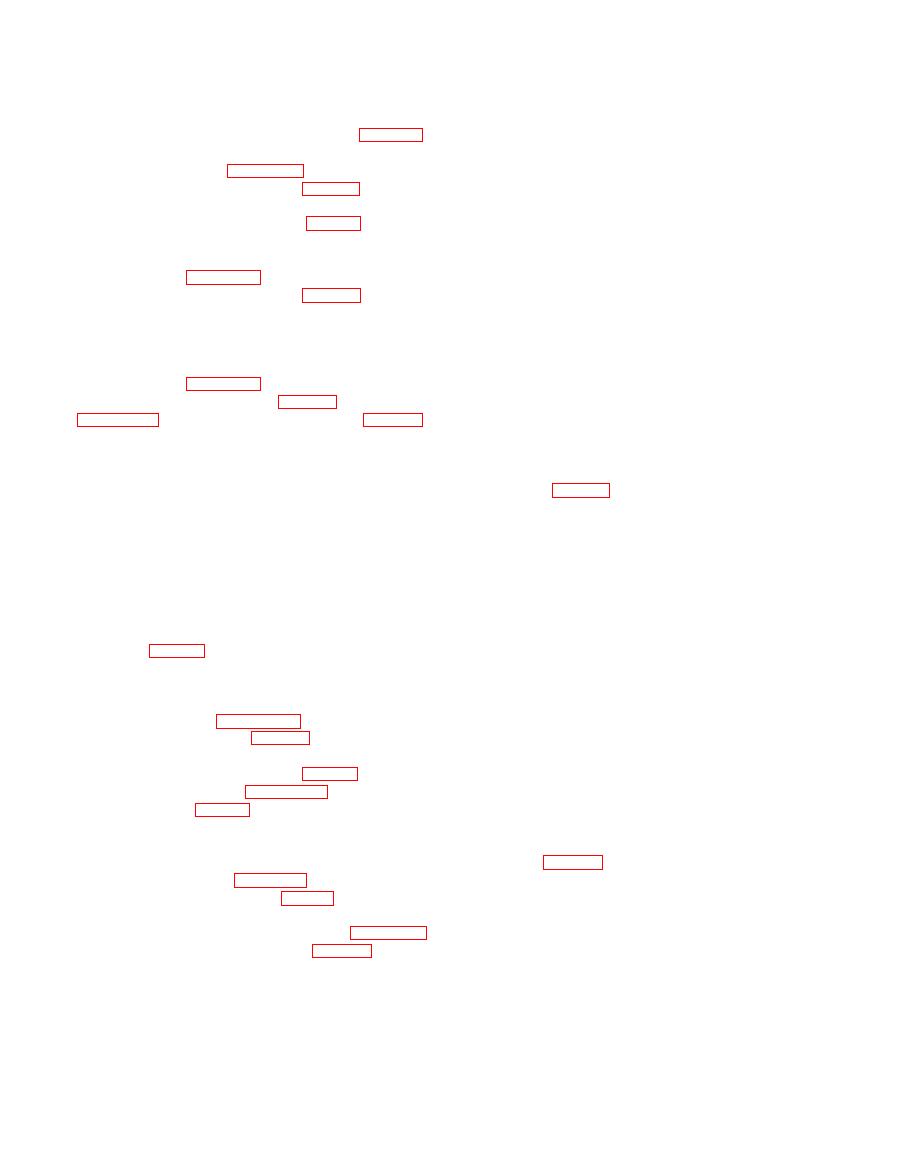 |
|||
|
|
|||
|
|
|||
| ||||||||||
|
|
 TM 10-3930-634-34
(9) Remove drum and hub (21) and retaining ring
(1.) Clean all metal parts (except bearings) with
(22) from idler shaft (23).
cleaning solvent P-D-680 and dry thoroughly.
h. Reverse and Third Clutch Disassembly.
(2) Clean bearings with volatile mineral spirits.
Lubricate bearings immediately after cleaning.
(1) Remove three piston rings (3, fig. 4-50),
retaining ring, (4) and using a bearing puller, remove
NOTE
bearing (5) as shown in figure 4-47, A.
Never use compressed air to dry bearings.
(2) Remove retaining ring (4, fig. 4-50) and using
Never spin bearings which have not been
lubricated.
a gear puller remove driven gear (6) as shown in figure
4-47, B. Remove retraining rings (8, fig. 4-50) and us-
(3) With a flexible wire brush, clean passage ways
ing an arbor press, remove bearing (7) from gear (6).
of all tubes in transmission front cover and transmis-
(3) Remove baffle ring (9) and pull inner bearing
sion case.
(10) as shown in figure 4-47, C.
(4) Discard all packings and gaskets.
k. Forward and Second Clutch Inspection and Re-
(4) Remove rear bearing (11, fig. 4-50) and third
pair.
gear (12).
(5) Remove bearing (13), retaining rings (14), baf-
(1) Inspect bearings for roughness of rotation,
fle ring (15) and bearing spacer (16).
chipped, nicked, pitted, or excessive wear. Replace
bearings if any of these defects are found.
(6) Using a bearing puller remove inner bearing
(2) Replace seal rings with new parts.
(17) as shown in figure 4-47, C.
(3) Inspect gears and splined parts for chips,
(7) Compress spring (20, fig. 4-50), as shown in
scuffs, nicks, burrs, and excessive wear. Remove burrs
with a soft stone. Replace defective parts.
spring retainer (19) and spring (20). Remove spring
(4) Inspect return springs for cracks, breaks, dis-
(20) from the opposite end of the reverse and third
tortion or evidence of permanent set. Free length of
clutch pack assembly in the same manner.
springs (14, fig. 4-46) is 2.170 inches. Load length of
(8) Remove retaining ring (21), end plate (22), six
1.50 inches requires a load of 80 to 100 pounds.
inner discs (23), outer discs (24), clutch piston (25) and
(5) Inspect inner and outer discs (17 and 18) for
seal rings (26 and 27). Disassemble the opposite end of
excessive wear, breaks, or cracks. Replace the defec-
the clutch pack in this same manner.
i. Low Clutch Disassembly.
tive part. The clutch pack is self adjusting; therefore,
the manufacturer does not provide maximum wear
NOTE
Do not mix low clutch discs with other clutch
limits.
(6) Inspect retaining rings for distortion, breaks,
discs.
(1) With an internal type puller, remove pilot
nicks, or other damage. Replace defective retaining
rings. Ring must snap tight in its groove for proper
bearing (4, fig. 4-51) from end of drum and shaft (24).
functioning.
(2) Remove two piston rings (6) from rear of
1. Fourth Speed Clutch Inspection and Repair
clutch shaft.
(1) Inspect bearings for roughness of rotation,
(3) Remove inner race of bearing (7) using a bear-
chipped, nicked, pitted, or worn condition. Replace
ing puller shown in figure 4-52, A. The outer race
with rollers of bearing (7, fig. 4-51) must be pressed
bearing if any of these defects are found.
(2) Replace seal rings with new parts.
out the rear side of the transmission case.
(3) Inspect gears and splined parts for chipped,
(4) Remove retaining ring (8, fig. 4-51) and using
scuffed, nicked, burred, or worn conditions. Remove
a gear puller as shown in figure 4-52, B, remove the
burrs with a soft stone. Replace defective parts.
low speed gear (9, fig. 4-51). The outer cone and roll-
(4) Inspect return springs for cracks, breaks,
ers, both cups and retaining rings of bearing assembly
distortion or evidence of permanent set. Free length of
(10) may now be removed from the gear.
spring (10, fig. 4-48) is 2.170 inches. Load length of
(5) Remove inner cone and rollers of bearing as-
1.50 inches requires a load of 80 to 100 pounds.
sembly (10) as shown in figure 4-52, C.
(5) Inspect inner and outer discs (1.4 and 15) for
(6) Remove baffle ring (11, fig. 4-51) and retain-
ing ring (12).
evidence of excessive wear, breaks, or cracks. The
clutch pack is self adjusting; therefore, the manufac-
(7) Compress spring (15), as shown in figure 4-52,
D, and remove retaining ring (13, fig. 4-51), spring
turer does not provide maximum wear limits.
retainer (14), spring (15) and spring retainer (16).
(6) Inspect retaining rings for distortion, breaks,
(8) Remove retaining ring (17), end plate (18),
nicks, or other damage. Replace defective retaining
nine inner discs (19), nine outer discs (20), clutch
rings. Ring must snap tight in its groove for proper
functioning.
piston (21), seal ring (22) and seal ring (23) from drum
m. Reverse and Third Clutch Inspection and Repair.
and shaft (24).
(1) Inspect bearings for roughness of rotation,
j. Cleaning
4-21
|
|
Privacy Statement - Press Release - Copyright Information. - Contact Us |